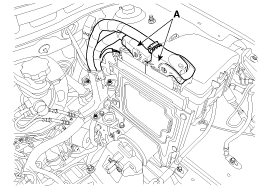Kia Cadenza: Automatic Transaxle Control System / Transaxle Control Module (TCM) Repair procedures
Kia Cadenza YG 2016-2025 Service Manual / Automatic Transaxle System / Automatic Transaxle Control System / Transaxle Control Module (TCM) Repair procedures
| Removal |
When replacing the TCM, the vehicle equipped with the immobilizer must be performed procedure as below.
[In the case of installing used TCM]
[In the case of installing new TCM]
Perform "Key teaching" procedure with GDS.
(Refer to Body Electrical System - "Immobilizer System") |
When replacing the TCM, the vehicle equipped with the smart key system (Button start) must be performed procedure as below.
[In the case of installing used TCM]
[In the case of installing new TCM]
Insert the key (or press the start button) and turn it to the
IGN ON and OFF position. Then the TCM learns the smart key information
automatically. |
| 1. |
Turn ignition switch OFF and disconnect the negative (-) battery cable. |
| 2. |
Remove the battery.
(Refer to Engine Electrical System - "Battery") |
| 3. |
Remove the air cleaner assembly.
(Refer to Engine Mechanical System - "Air Cleaner") |
| 4. |
Disconnect the TCM Connector (A).
|
| 5. |
Remove the mounting bolts (A) and nut (B), and then remove the TCM (C).
|
| Installation |
When replacing the TCM, the vehicle equipped with the immobilizer must be performed procedure as below.
[In the case of installing used TCM]
[In the case of installing new TCM]
Perform "Key teaching" procedure with GDS.
(Refer to Body Electrical System - "Immobilizer System") |
When replacing the TCM, the vehicle equipped with the smart key system (Button start) must be performed procedure as below.
[In the case of installing used TCM]
[In the case of installing new TCM]
Insert the key (or press the start button) and turn it to the
IGN ON and OFF position. Then the TCM learns the smart key information
automatically. |
| 1. |
Install in the reverse order of removal.
|
TCM Problem Inspection Procedure
| 1. |
TEST TCM GROUND CIRCUIT: Measure resistance between TCM and
chassis ground using the backside of TCM harness connector as TCM side
check point. If the problem is found, repair it.
|
| 2. |
TEST TCM CONNECTOR: Disconnect the TCM connector and visually
check the ground terminals on TCM side and harness side for bent pins
or poor contact pressure. If the problem is found, repair it. |
| 3. |
If problem is not found in Step 1 and 2, the TCM could be
faulty. If so, make sure there were no DTC''s before swapping the TCM
with a new one, and then check the vehicle again. If DTC''s were found,
examine this first before swapping TCM. |
| 4. |
RE-TEST THE ORIGINAL TCM: Install the original TCM (may be
broken) into a known-good vehicle and check the vehicle. If the problem
occurs again, replace the original TCM with a new one. If problem does
not occur, this is intermittent problem (Refer to “Intermittent
Problem Inspection Procedure” in Basic Inspection Procedure). |
 Transaxle Control Module (TCM) Schematic Diagrams
Transaxle Control Module (TCM) Schematic Diagrams
1. TCM connector and terminal function
2. TCM terminal function
Connector [A]
PinDescriptionPinDescription1-45Inhibitor switch signal ''S2''2-46Inhibitor switch signal ''S3''3-47Inhibitor swi ...
 Transaxle Oil Temperature Sensor Description and Operation
Transaxle Oil Temperature Sensor Description and Operation
Description
Transaxle oil temperature sensor monitors the automatic
transaxle fluid''s temperature and conveys the readings to TCM. It is an
Negative Thermal Coefficient(NTC) sensor whose resis ...
Other information:
Kia Cadenza YG 2016-2025 Service Manual: Steering Wheel Remote Controller (SWRC) Schematic Diagrams
Circuit Diagram ...
Kia Cadenza YG 2016-2025 Service Manual: Specifications
Specifications AVN Head Unit ItemSpecificationPower sourceDC 14.4V (-) groundFrequency range / Channel spaceFM : 87.5 ~ 107.9 MHz / 200 KHzAM : 530 ~ 1710 KHz / 10 KHzTuning typePLL SYNTHESIZED TUNINGImpedance2 ohm x 4Antenna80 pF 75 OhmDark currentMax. 2mA (Head unit only)S/NFM : MIN 50 dBAM ...
Copyright © www.kcadenzavg.com 2017-2025




